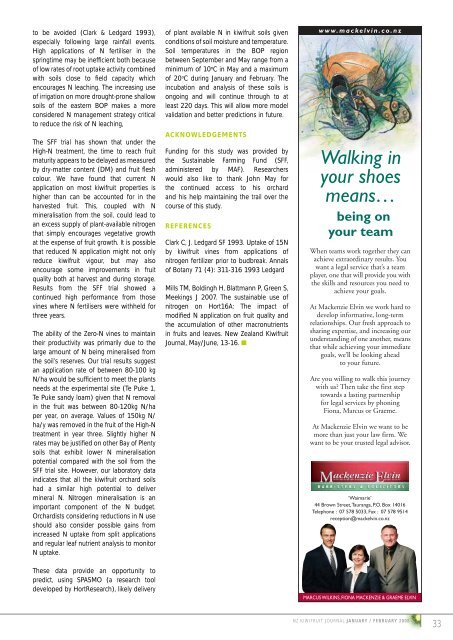Thirsty vines Summer girdling Compost teas Organic marketing The ...
Thirsty vines Summer girdling Compost teas Organic marketing The ...
Thirsty vines Summer girdling Compost teas Organic marketing The ...
Create successful ePaper yourself
Turn your PDF publications into a flip-book with our unique Google optimized e-Paper software.
to be avoided (Clark & Ledgard 1993),<br />
especially following large rainfall events.<br />
High applications of N fertiliser in the<br />
springtime may be ineffi cient both because<br />
of low rates of root uptake activity combined<br />
with soils close to fi eld capacity which<br />
encourages N leaching. <strong>The</strong> increasing use<br />
of irrigation on more drought-prone shallow<br />
soils of the eastern BOP makes a more<br />
considered N management strategy critical<br />
to reduce the risk of N leaching,<br />
<strong>The</strong> SFF trial has shown that under the<br />
High-N treatment, the time to reach fruit<br />
maturity appears to be delayed as measured<br />
by dry-matter content (DM) and fruit fl esh<br />
colour. We have found that current N<br />
application on most kiwifruit properties is<br />
higher than can be accounted for in the<br />
harvested fruit. This, coupled with N<br />
mineralisation from the soil, could lead to<br />
an excess supply of plant-available nitrogen<br />
that simply encourages vegetative growth<br />
at the expense of fruit growth. It is possible<br />
that reduced N application might not only<br />
reduce kiwifruit vigour, but may also<br />
encourage some improvements in fruit<br />
quality both at harvest and during storage.<br />
Results from the SFF trial showed a<br />
continued high performance from those<br />
<strong>vines</strong> where N fertilisers were withheld for<br />
three years.<br />
<strong>The</strong> ability of the Zero-N <strong>vines</strong> to maintain<br />
their productivity was primarily due to the<br />
large amount of N being mineralised from<br />
the soil’s reserves. Our trial results suggest<br />
an application rate of between 80-100 kg<br />
N/ha would be suffi cient to meet the plants<br />
needs at the experimental site (Te Puke 1,<br />
Te Puke sandy loam) given that N removal<br />
in the fruit was between 80-120kg N/ha<br />
per year, on average. Values of 150kg N/<br />
ha/y was removed in the fruit of the High-N<br />
treatment in year three. Slightly higher N<br />
rates may be justifi ed on other Bay of Plenty<br />
soils that exhibit lower N mineralisation<br />
potential compared with the soil from the<br />
SFF trial site. However, our laboratory data<br />
indicates that all the kiwifruit orchard soils<br />
had a similar high potential to deliver<br />
mineral N. Nitrogen mineralisation is an<br />
important component of the N budget.<br />
Orchardists considering reductions in N use<br />
should also consider possible gains from<br />
increased N uptake from split applications<br />
and regular leaf nutrient analysis to monitor<br />
N uptake.<br />
<strong>The</strong>se data provide an opportunity to<br />
predict, using SPASMO (a research tool<br />
developed by HortResearch), likely delivery<br />
of plant available N in kiwifruit soils given<br />
conditions of soil moisture and temperature.<br />
Soil temperatures in the BOP region<br />
between September and May range from a<br />
minimum of 10 o C in May and a maximum<br />
of 20 o C during January and February. <strong>The</strong><br />
incubation and analysis of these soils is<br />
ongoing and will continue through to at<br />
least 220 days. This will allow more model<br />
validation and better predictions in future.<br />
ACKNOWLEDGEMENTS<br />
Funding for this study was provided by<br />
the Sustainable Farming Fund (SFF,<br />
administered by MAF). Researchers<br />
would also like to thank John May for<br />
the continued access to his orchard<br />
and his help maintaining the trail over the<br />
course of this study.<br />
REFERENCES<br />
Clark C, J. Ledgard SF 1993. Uptake of 15N<br />
by kiwifruit <strong>vines</strong> from applications of<br />
nitrogen fertilizer prior to budbreak. Annals<br />
of Botany 71 (4): 311-316 1993 Ledgard<br />
Mills TM, Boldingh H, Blattmann P, Green S,<br />
Meekings J 2007. <strong>The</strong> sustainable use of<br />
nitrogen on Hort16A: <strong>The</strong> impact of<br />
modifi ed N application on fruit quality and<br />
the accumulation of other macronutrients<br />
in fruits and leaves. New Zealand Kiwifruit<br />
Journal, May/June, 13-16. ■<br />
NZ KIWIFRUIT JOURNAL JANUARY / FEBRUARY 2008<br />
33


